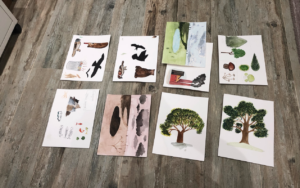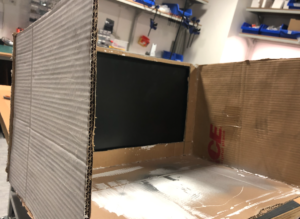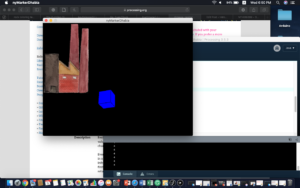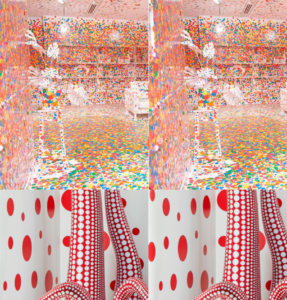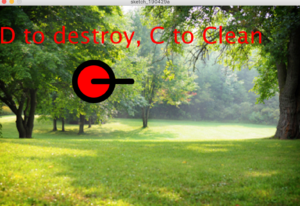After all the mental breakdowns and the literal physical pain, this semester has come to a close. My final project wanted to raise some sort of awareness on the environment and on the dangers of consumption and greed. Although it did come out a bit more comical than I intended it to, I think my final project was a success as it made people laugh, have fun and more importantly, think.
I survived intro to interactive media (surprisingly) and came out with a really good project, I’m so happy with it!!! pic.twitter.com/eXahdjfgTp
— ظبية (@nolongergrey) May 16, 2019
These are all the paintings for the interface, done with watercolors:
The box went from this:
To this:
I still think it would’ve looked nicer with wood, but for something DIY-ed I think it looks really good.
This is the code for my final project, never thought I’d say this in my life but I’m glad the code got deleted because I actually learned a lot while working and figuring things out. The funniest thing was attempting to add the sounds to the program last minute, and it actually worked!!!!
import processing.sound.*;
SoundFile beep;
SoundFile happy;
SoundFile scary;
import processing.video.*;
import jp.nyatla.nyar4psg.*;
PImage background;
PImage background2;
PImage tree;
PImage tree2;
PImage bush;
PImage mushroom;
PImage factory;
PImage waterBottle;
PImage TrashCan;
PImage bags;
PImage bear;
PImage dBear;
PImage lily;
PImage lily2;
PImage fish1;
PImage fish2;
PImage fish3;
PImage deadFish1;
PImage deadFish2;
PImage deadFish3;
PImage bird;
PImage bird2;
PImage bird3;
PImage bird4;
PImage deadBirdPic;
PImage deadBirdPic2;
Movie Apocalypse;
int value = 0;
Capture cam;
MultiMarker nya;
int[] objects = {1, 2, 3, 4, 5, 6, 7, 8, 9, 0};
int i = objects.length;
boolean b = true;
boolean backgroundB = false;
boolean factoryPic = false;
boolean trashCan = false;
boolean bag = false;
boolean bottle =false;
boolean apocalypse = false;
boolean deadBird = true;
boolean treesGone = true;
boolean deadBear = true;
boolean fish = true;
boolean Badmusic = false;
void setup() {
//size(1920, 1080, P3D);
fullScreen(P3D, 2);
colorMode(RGB, 100);
String[] cameras = Capture.list();
//printArray(cameras);
cam = new Capture(this, cameras[0]);
//cam=new Capture(this, 1280,700);
nya=new MultiMarker(this, 1920, 1080, "camera_para.dat", NyAR4PsgConfig.CONFIG_PSG);
Apocalypse = new Movie(this, "fire.mov");
beep = new SoundFile(this, "beep.wav");
scary = new SoundFile(this, "thunder.wav");
happy = new SoundFile(this, "nature.wav");
background = loadImage("background.png");
background2 = loadImage("background2.png");
factory = loadImage("factory4.png");
TrashCan = loadImage("trashcan.png");
bags = loadImage("bags.png");
waterBottle = loadImage("waterBottle.png");
tree = loadImage("tree.png");
bush = loadImage("bush.png");
tree2 = loadImage("tree2.png");
bear = loadImage("bear.png");
dBear = loadImage("deadBear.png");
bird = loadImage("bird.png");
bird2 = loadImage("bird2.png");
bird3 = loadImage("bird3.png");
bird4 =loadImage ("bird4.png");
deadBirdPic = loadImage("deadBird.png");
deadBirdPic2 = loadImage("deadBird2.png");
fish1 = loadImage("fish1.png");
fish2 = loadImage("fish2.png");
fish3 = loadImage("fish3.png");
deadFish1 = loadImage("deadfish1.png");
deadFish2 = loadImage("deadfish2.png");
deadFish3 = loadImage("deadfish3.png");
lily = loadImage("lily1.png");
lily2 = loadImage("lily2.png");
fish1.resize(80,100);
fish2.resize(80,100);
fish3.resize(100,80);
deadFish1.resize(120,80);
deadFish2.resize(120,80);
deadFish3.resize(120,80);
tree.resize(600, 750);
tree2.resize(500,600);
bush.resize(200,400);
bear.resize(280, 400);
dBear.resize(450,180);
bird.resize(200, 200);
bird2.resize(200, 200);
bird3.resize(200,100);
bird4.resize(200,200);
deadBirdPic.resize(200,100);
deadBirdPic2.resize(300,100);
factory.resize(350, 550);
TrashCan.resize(400,600);
bags.resize(500,400);
//dBear.resize(,)
factory.resize(400, 600);
for (int c = 0; c < i; c++) {
nya.addNyIdMarker(c, 80);
}
cam.start();
background(background);
noCursor();
}
void draw() {
if (cam.available()!=true) {
return;
}
cam.read();
nya.detect(cam);
background(background);
image(Apocalypse, 0, 0);
//if (b) {
// pushStyle();
// imageMode(CORNER);
// pushMatrix();
// //translate(1280/2,700/2);
// nya.drawBackground(cam);
// popMatrix();
// popStyle();
//}
//Apocalypse.resize(displayWidth,displayHeight); how do i make the video fullscreen?
//use some app and rezise and change the Apocalypse video before class on Monday please please please Dhabiaaaa
for (int c = 0; c < i; c++) {
if ((!nya.isExist(c))) {
//println(nya.getNyId(c));
//println("returning");
continue;
}
if (c==1) {
if (!beep.isPlaying() && deadBear==true){
beep.play();
}
else{
beep.stop();
}
//Bear turns to carpet code
deadBear = false;
break;
}
if (c==2 && treesGone == true) {
treesGone = false;
if (!beep.isPlaying()){
beep.play();
}
else{
beep.stop();
} //tree falls code because of table or chair or maybe both????
}
if (c==3 && trashCan == false) {
if (!beep.isPlaying()){
beep.play();
}
else{
beep.stop();
}
trashCan = true;
}
if (c==4&& factoryPic==false) {
factoryPic = true;
if (!beep.isPlaying()){
beep.play();
}
else{
beep.stop();
}
}
if (c==5 && fish == true) {
if (!beep.isPlaying()){
beep.play();
}
else{
beep.stop();
} //fish
fish = false;
}
if (c==6 && deadBird == true) {
if (!beep.isPlaying()){
beep.play();
}
else{
beep.stop();
} //bird dies
deadBird = false;
}
if (c==7 && bag == false) {
if (!beep.isPlaying()){
beep.play();
}
else{
beep.stop();
} bag = true;
}
if (c==8 && backgroundB ==false) {
if (!beep.isPlaying()){
beep.play();
}
else{
beep.stop();
} backgroundB = true;
}
if (c==9) {
}
if (c==0 && apocalypse == false) {
if (!beep.isPlaying()){
beep.play();
}
else{
beep.stop();
} //don't forget to rezie the video + add a text that says, real life has no reset button
Apocalypse.loop();
apocalypse=true;
}
}
if (backgroundB){
background(background2);
}
if (bag && apocalypse == false){
image(bags, 1100, 250); //fix
}
if (!deadBird && apocalypse==false){
image(deadBirdPic, 80,780);
image(deadBirdPic2, 600, 450);
}
if (deadBird && apocalypse==false){
image(bird, 800, 100);
image(bird2, 100, 50);
image(bird3, 1000, 50);
image(bird4, 500, 50);
}
if (fish && apocalypse == false){
image(fish1,700,750);
image(fish2,500,740);
image(fish3,900,730);
image(lily,1000,740);
image(lily2,800,720);
}
if (!fish && apocalypse == false){
image(deadFish1,700,750);
image(deadFish2,1100,730);
image(deadFish3,900,730);
}
if (treesGone && apocalypse == false){
image(tree2,1000,100);
image(tree, 1300, 0);
image(bush,1300,500);
//Add more trees
}
if (deadBear && apocalypse == false){
image(bear, 250, 600);
}
if (trashCan && apocalypse == false){
image(TrashCan, 1400, 550); //fix
}
if (factoryPic) {
image(factory, 0, 0);
}
if (!deadBear && apocalypse == false){
image(dBear,100,500);
}
if (!apocalypse){
if (!happy.isPlaying()){
happy.loop();
}
}
if (apocalypse) {
if (happy.isPlaying()){
scary.loop();
if (scary.isPlaying()){
happy.stop();
}
}
image(Apocalypse, 0, 0);
textSize(80);
text("Real life has no reset button", 50, 80);
factoryPic = false;
treesGone = false;
deadBird=true;
}
}
void keyPressed() {
if (keyPressed) {
if (key == 'b' || key == 'B') {
b = !b;
}
}
}
void movieEvent(Movie m) {
m.read();
}

